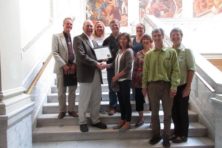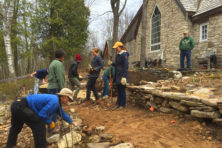Wisconsin Could Increase Tax Credit for Renovating Historic Structures
- Share
- Tweet
- Pin
- Share
Two bills in the state legislature would increase the amount of tax relief given to private developers fixing up historic buildings.
“It’s nice to save some of these historic buildings and put some new uses in them, and oftentimes there’s additional cost associated with reusing and repurposing historic buildings,” said Bill Chaudoir, executive director of the Door County Economic Development Corporation. “I think the purpose of the tax credit is to offset some of those additional costs and provide an incentive for someone to go through the trouble of reusing a historic building.”
Encouraging legislators to support the bills, which would increase the credits from five to 20 percent, was one of the goals of Door and Kewaunee County Legislative Days in May. The increase would bring the state’s tax credit in line with the 20 percent federal tax credit.
Increasing the kickback to historic building developers could help the city of Sturgeon Bay with its West Waterfront Redevelopment project. The city has plans to sell the property’s granary to a developer who will hopefully renovate the space into a four-season indoor farmers market, a potentially expensive project.
“It would be a really nice tool for us to use to try to attract a developer if we could offer these tax credits,” Chaudoir said.
The legislature has yet to vote on the bills, but in its proposed biennial budget the Joint Finance Committee has proposed increasing the tax credit to 10 percent.
“Even going from five percent to 10 percent is an incentive,” said Sturgeon Bay community development director Marty Olejniczak. “A lot of times it costs more to renovate an old building rather than build new.”
Wisconsin uses the National Park Service’s criteria for historic structures and places; so, in order for a building to be named historic, it must be associated with significant historic people or events, be more than 50 years old and embody distinctive physical characteristics.
Renovations to designated historic structures have to be done in a historically accurate way, said George Evenson, president of the Door County Historical Society.
“If you’re going to do it, you want it to be detailed and historically accurate,” Evenson said. “It’s going to require a skilled carpenter, special lumber to match the lumber that’s taken out, also the hardware that matches the era… It’s very expensive to do that, and people might have a little more incentive to do it if they had additional tax credit.”
The granary hasn’t been named a historic structure yet, but Olejniczak said it could fit the state and national criteria.
“This is the last one left that reminds us of when Sturgeon Bay was an ag community,” Olejniczak said. “So, locally, I think the argument could be made it’s a historic structure, but from a state or national perspective it might be different.”
Sturgeon Bay just hired a firm to do a structural analysis of the granary to see how much work a developer would have to do to renovate the building and if it makes sense to keep the building at all, something Olejniczak said officials need to know before they can decide how to proceed with the rest of the redevelopment project.
“A lot of what we’re doing on the West Waterfront Redevelopment Project hinges on that building,” he said. “A lot of the other pieces of the puzzle could start to fall into place once we know about this.”
Other parts of the redevelopment project, like designing the festival pier and the waterfront walkway, will likely happen this summer as well. Olejniczak said construction would not start until the city hears of private investment that would create tax revenue to justify the cost of the public improvements.


